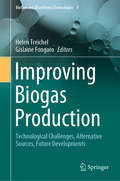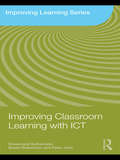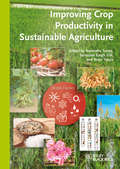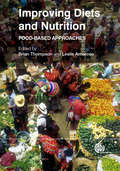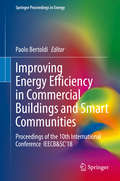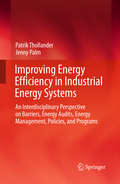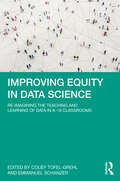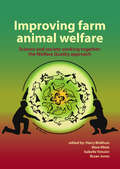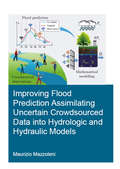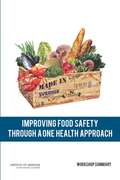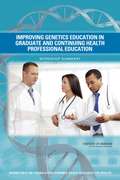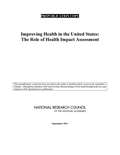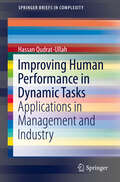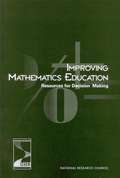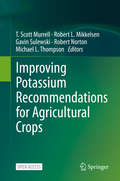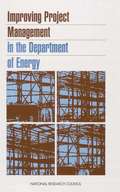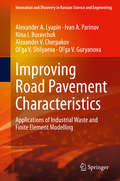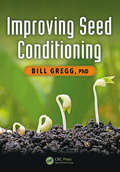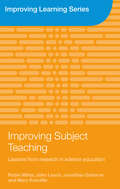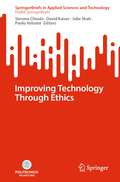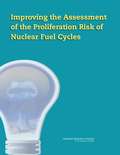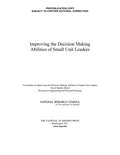- Table View
- List View
Improving Biogas Production: Technological Challenges, Alternative Sources, Future Developments (Biofuel and Biorefinery Technologies #9)
by Helen Treichel Gislaine FongaroThis book highlights the current limitations of biogas production and yield and new avenues to improving them. Biogas production and yield are among the most important renewable energy targets for our world. Pursuing an innovative and biotechnological approach, the book presents alternative sources for biogas production and explores a broad range of aspects, including: pre-treatment of substrates, accelerators (enzyme-mediated) and inhibitors involved in the process of obtaining biogas and its yield, design specifications for digesters/modified digesters, managing biogas plants, microbial risk and slurry management, energy balance and positive climatic impacts of the biogas production chain, and the impacts on Human, Animal and Environmental Health (“One Health” concept for the biogas chain).
Improving Classroom Learning with ICT (Improving Learning)
by Rosamund Sutherland Susan Robertson Peter JohnImproving Classroom Learning with ICT examines the ways in which ICT can be used in the classroom to enhance teaching and learning in different settings and across different subjects. Weaving together evidence of teachers’ and learners’ experiences of ICT, the authors: explain why the process of integrating ICT is not straightforward; discuss whether hardware and infrastructure alone are sufficient to ensure full integration and exploitation of ICT investment; emphasise the pivotal role that teachers play in supporting learning with ICT across the curriculum; argue that teachers need a greater understanding of how to put ICT to use in teaching and learning; highlight that out-of-school use of ICT has an impact on in-school learning; consider what kinds of professional development are most effective in supporting teachers to use technologies creatively and productively. Case studies are used to illustrate key issues and to elaborate a range of theoretical ideas that can be used in the classroom. This book will be of interest to all those concerned with maximising the benefits of ICT in the classroom.
Improving Crop Productivity in Sustainable Agriculture
by Narendra Tuteja Sarvajeet Singh Gill Renu TutejaAn up-to-date overview of current progress in improving crop quality and quantity using modern methods. With a particular emphasis on genetic engineering, this text focusses on crop improvement under adverse conditions, paying special attention to such staple crops as rice, maize, and pulses. It includes an excellent mix of specific examples, such as the creation of nutritionally-fortified rice and a discussion of the political and economic implications of genetically engineered food. The result is a must-have hands-on guide, ideally suited for the biotech and agro industries.
Improving Decisionmaking in a Turbulent World: Strategic Rethink
by Charles P. RiesEvery president needs a decisionmaking system that harnesses the full capabilities and accumulated wisdom of the U.S. government and the nation's many stakeholders. This Perspective analyzes a range of management challenges in the national security system and presents recommendations for strengthening U.S. decisionmaking and oversight of policy implementation.
Improving Diets and Nutrition: Food-based Approaches (Co-published With The Food And Agriculture Organization Of The United Nations (fao) Ser.)
by Brian Thompson Leslie AmorosoNutrition-sensitive, food-based approaches towards hunger and malnutrition are effective, sustainable and long-term solutions. This book discusses the policy, strategic, methodological, technical and programmatic issues associated with such approaches, proposes “best practices” for the design, targeting, implementation and evaluation of specific nutrition-sensitive, food-based interventions and for improved methodologies for evaluating their efficacy and cost-effectiveness, and provides practical lessons for advancing nutrition-sensitive food-based approaches for improving nutrition at policy and programme level.
Improving Energy Efficiency in Commercial Buildings and Smart Communities: Proceedings of the 10th International Conference IEECB&SC’18 (Springer Proceedings in Energy)
by Paolo BertoldiThese proceedings present fourteen peer-reviewed papers from the 10th International Conference on Improving Energy Efficiency in Commercial Buildings and Smart Communities, which was held March 21-22, 2018 in Frankfurt, Germany. This biannual conference aims to promote and diffuse the concept of energy efficiency in new and existing commercial buildings and to enlarge the market for low consumption and sustainable non-residential buildings. It also covers smart and sustainable districts, communities and cities, since energy systems efficiency and renewable energies are often optimized at the district or municipal level. The 2018 conference focused on advanced and innovative technologies to improve the energy efficiency of commercial buildings, communities and cities as well as the policies and measures by governments at various levels to improve energy efficiency. A particular focus was on Energy Service Companies (ESCOs). The conference addresses energy policy makers at international, national, and local level; academics, researchers and energy efficiency experts; ESCOs, utilities, buildings energy and environmental managers; buildings engineers and architects; and equipment manufacturers and commercial property investors.
Improving Energy Efficiency in Industrial Energy Systems
by Jenny Palm Patrik ThollanderIndustrial energy efficiency is one of the most important means of reducing the threat of increased global warming. Research however states that despite the existence of numerous technical energy efficiency measures, its deployment is hindered by the existence of various barriers to energy efficiency. The complexity of increasing energy efficiency in manufacturing industry calls for an interdisciplinary approach to the issue. Improving energy efficiency in industrial energy systems applies an interdisciplinary perspective in examining energy efficiency in industrial energy systems, and discusses how "cross-pollinating" perspectives and theories from the social and engineering sciences can enhance our understanding of barriers, energy audits, energy management, policies, and programmes as they pertain to improved energy efficiency in industry. Apart from classical technical approaches from engineering sciences, Improving energy efficiency in industrial energy systems couples a sociotechnical perspective to increased energy efficiency in industry, showing that industrial energy efficiency can be expected to be shaped by social and commercial processes and built on knowledge, routines, institutions, and methods established in networks. The book can be read by researchers and policy-makers, as well as scholars and practicians in the field. "This book is extremely valuable for anyone who is designing or executing energy efficiency policies, schemes or projects aiming at SMEs. Both authors deserve the highest respect, and the combination of their expertise makes the results truly unique." - Daniel Lundqvist, programme manager at the Swedish energy agency "For anyone interested in improving energy efficiency in industry, this is a must-read. The book combines tools from social science and engineering to discuss the state of art today as well as possible development path tomorrow. This is a compelling book that I find useful both in my teaching and my research." - Kajsa Ellegård, Professor at Linköping University, Sweden "The book Improving energy efficiency in industrial energy systems is a novel approach on how improved levels of energy efficiency can be reached in industrial energy systems by merging engineering with social sciences. It is with delight that I can recommend their book to anyone interested in the field."- Mats Söderström, Director Energy Systems Programme, Linköping University, Sweden
Improving Equity in Data Science: Re-Imagining the Teaching and Learning of Data in K-16 Classrooms
by Colby Tofel-Grehl Emmanuel SchanzerImproving Equity in Data Science offers a comprehensive look at the ways in which data science can be conceptualized and engaged more equitably within the K-16 classroom setting, moving beyond merely broadening participation in educational opportunities. This book makes the case for field wide definitions, literacies and practices for data science teaching and learning that can be commonly discussed and used, and provides examples from research of these practices and literacies in action. Authors share stories and examples of research wherein data science advances equity and empowerment through the critical examination of social, educational, and political topics. In the first half of the book, readers will learn how data science can deliberately be embedded within K-12 spaces to empower students to use it to identify and address inequity. The latter half will focus on equity of access to data science learning opportunities in higher education, with a final synthesis of lessons learned and presentation of a 360-degree framework that links access, curriculum, and pedagogy as multiple facets collectively essential to comprehensive data science equity work.Practitioners and teacher educators will be able to answer the question, “how can data science serve to move equity efforts in computing beyond basic inclusion to empowerment?” whether the goal is to simply improve definitions and approaches to research on data science or support teachers of data science in creating more equitable and inclusive environments within their classrooms.
Improving farm animal welfare: the Welfare Quality approach
by Mara Miele Isabelle Veissier Bryan Jones H. J. BlokhuisHow do you define the quality of life of a farmed animal? This timely book addresses the complex and often controversial issues surrounding the assessment and improvement of farm animal welfare. Based on a large, multi-disciplinary EU funded research project called Welfare Quality, it discusses the relevance of science based welfare assessments and the importance of establishing a fruitful dialogue between science and society. An outline is given of the development of a workable welfare assessment system for cattle, pigs and chickens as well as practical ways of improving the animals' quality of life. This book synthesises the huge body of work carried out by the largest ever international network of scientists and stakeholders in Welfare Quality. It describes some of the obstacles encountered and their solution and why particular paths were chosen. It also clearly sets out what still needs to be done and presents selected strategies and technologies (automation, proxy indicators, targeting of risk factors, etc.) designed to ensure the continued improvement of welfare and its assessment. The book provides a valuable source of knowledge on farm animal welfare for social and animal scientists, students, teachers, policy makers, lobby groups and the animal industry.
Improving Flood Prediction Assimilating Uncertain Crowdsourced Data into Hydrologic and Hydraulic Models (IHE Delft PhD Thesis Series)
by Maurizio MazzoleniIn recent years, the continued technological advances have led to the spread of low-cost sensors and devices supporting crowdsourcing as a way to obtain observations of hydrological variables in a more distributed way than the classic static physical sensors. The main advantage of using these type of sensors is that they can be used not only by technicians but also by regular citizens. However, due to their relatively low reliability and varying accuracy in time and space, crowdsourced observations have not been widely integrated in hydrological and/or hydraulic models for flood forecasting applications. Instead, they have generally been used to validate model results against observations, in post-event analyses. This research aims to investigate the benefits of assimilating the crowdsourced observations, coming from a distributed network of heterogeneous physical and social (static and dynamic) sensors, within hydrological and hydraulic models, in order to improve flood forecasting. The results of this study demonstrate that crowdsourced observations can significantly improve flood prediction if properly integrated in hydrological and hydraulic models. This study provides technological support to citizen observatories of water, in which citizens not only can play an active role in information capturing, evaluation and communication, leading to improved model forecasts and better flood management.
Improving Food Safety Through a One Health Approach
by Eileen R. ChoffnesGlobalization of the food supply has created conditions favorable for the emergence, reemergence, and spread of food-borne pathogens-compounding the challenge of anticipating, detecting, and effectively responding to food-borne threats to health. In the United States, food-borne agents affect 1 out of 6 individuals and cause approximately 48 million illnesses, 128,000 hospitalizations, and 3,000 deaths each year. This figure likely represents just the tip of the iceberg, because it fails to account for the broad array of food-borne illnesses or for their wide-ranging repercussions for consumers, government, and the food industry-both domestically and internationally. A One Health approach to food safety may hold the promise of harnessing and integrating the expertise and resources from across the spectrum of multiple health domains including the human and veterinary medical and plant pathology communities with those of the wildlife and aquatic health and ecology communities. The IOM's Forum on Microbial Threats hosted a public workshop on December 13 and 14, 2011 that examined issues critical to the protection of the nation's food supply. The workshop explored existing knowledge and unanswered questions on the nature and extent of food-borne threats to health. Participants discussed the globalization of the U. S. food supply and the burden of illness associated with foodborne threats to health; considered the spectrum of food-borne threats as well as illustrative case studies; reviewed existing research, policies, and practices to prevent and mitigate foodborne threats; and, identified opportunities to reduce future threats to the nation's food supply through the use of a "One Health" approach to food safety. Improving Food Safety Through a One Health Approach: Workshop Summary covers the events of the workshop and explains the recommendations for future related workshops.
Improving Genetics Education in Graduate and Continuing Health Professional Education: Workshop Summary
by Adam C. BergerMany health care providers do not have either the knowledge or the tools they need in order to apply genetic information in their day-to-day practices. This lack of support is contributing to a substantial delay in the translation of genetic research findings, when appropriate, into improvement in patient outcomes within the health care system. Although the need to improve genetics knowledge among health care providers is clear, the best approaches to educating health care providers in a way that produces meaningful changes in clinical practice are not, especially given the competing coursework and training needs that exist in today's increasingly complex health care settings. To examine the potential and the challenges of providing genetics education, the Roundtable on Translating Genomic-Based Research for Health of the Institute of Medicine hosted a workshop on August 18, 2014. The workshop examined a variety of approaches that could improve the teaching of genetics in the graduate and continuing education of health professionals; these approaches included online and interactive instruction, just-in-time approaches, the development of clinical decision-support tools, and the incorporation of genetics requirements into licensing and accreditation. This report summarizes the presentations and discussion of the event.
Improving Health In The United States
by The National Academy of SciencesDespite large expenditures on healthcare and medical technology, the United States still ranks 32nd in the world for life expectancy. The missing piece is the impact of factors such as housing quality, exposure to pollutants, food quality, and the lack of exercise--which leads to high obesity rates. Prepared by the Committee on Health Impact Assessment, this detailed work looks at integrating the possible effects on health into factors such as decisions over land use and provision of transportation options. The book closes with six appendixes, including a dictionary and a summary of health impact assessment guides. No index is provided. Annotation ©2012 Book News, Inc. , Portland, OR (booknews. com)
Improving How Universities Teach Science: Lessons from the Science Education Initiative
by Carl WiemanToo many universities remain wedded to outmoded ways of teaching. Too few departments ask whether what happens in their lecture halls is effective at helping students to learn and how they can encourage their faculty to teach better. But real change is possible, and Carl Wieman shows us how it can be done—through detailed, tested strategies.
Improving Human Performance in Dynamic Tasks: Applications in Management and Industry (SpringerBriefs in Complexity)
by Hassan Qudrat-UllahThis book is about improving human decision making and performance in complex, dynamic tasks. The defining characteristics of a dynamic decision task are that there are a number of decisions required, that decisions are interdependent and that the environment in which the decision is made is transient and feedback is pervasive. Examples of dynamic tasks include the sustainable management of renewable resources and how businesses might allocate resources for research and development (R&D) projects. Decision making in dynamic tasks can be improved through training with system dynamics–based interactive learning environments (ILE’s) that include systematic debriefing. Some key features of the book include its didactic approach, numerous tables, figures, and the multidimensional evaluative model. Researchers can use the developed “evaluation model” to gauge various decision-aiding technologies. How to Improve Human Performance in Dynamic Tasks appeals to those interested in the design and evaluation of simulation-based decision support systems, as well as policy makers, students, researchers, and industrialists concerned by the issue of improving human performance in organizational tasks.
Improving Mathematics Education: Resources for Decision Making
by Committee on Decisions That CountA report on Improving Mathematics Education
Improving Potassium Recommendations for Agricultural Crops
by T. Scott Murrell Robert L. Mikkelsen Gavin Sulewski Robert Norton Michael L. ThompsonThis open access book highlights concepts discussed at two international conferences that brought together world-renowned scientists to advance the science of potassium (K) recommendations for crops. There was general agreement that the potassium recommendations currently in general use are oversimplified, outdated, and jeopardize soil, plant, and human health. Accordingly, this book puts forward a significantly expanded K cycle that more accurately depicts K inputs, losses and transformations in soils. This new cycle serves as both the conceptual basis for the scientific discussions in this book and a framework upon which to build future improvements. Previously used approaches are critically reviewed and assessed, not only for their relevance to future enhancements, but also for their use as metrics of sustainability. An initial effort is made to link K nutrition in crops and K nutrition in humans. The book offers an invaluable asset for graduate students, educators, industry scientists, data scientists, and advanced agronomists.
Improving Project Management in the Department of Energy
by National Research CouncilThe U. S. Department of Energy has been at the center of many of the greatest achievements in science and engineering in this century. DOE spends billions of dollars funding projects - and plans to keep on spending at this rate. But, documentation shows that DOE's construction and environmental remediation projects take much longer and cost 50% more than comparable projects undertaken by other federal agencies, calling into question DOE's procedures and project management. What are the root causes for these problems?
Improving Road Pavement Characteristics: Applications of Industrial Waste and Finite Element Modelling (Innovation and Discovery in Russian Science and Engineering)
by Alexander A. Lyapin Ivan A. Parinov Nina I. Buravchuk Alexander V. Cherpakov Ol’ga V. Shilyaeva Ol’ga V. GuryanovaThe book presents original technologies developed by the authors and existing Russian experience in study and application of technogenic raw materials (such as burnt rocks of mine dumps and ash-slag waste) to R&D of road constructions with high-strength properties and long-life operation. Another direction of the book is connected with finite-element modeling pavement constructions on different soils. To this aim, corresponding theoretical solutions and numerical algorithms are realized in ANSYS software. The obtained numerical results are compared with existing experimental data for real road constituents. It presents particular results of the Russian schools of Mechanics and Material Sciences not previously available outside of Russia. Explains original theoretical and experimental methods developed for solution of the problems of effective using technogenic waste in building and road constructions;Facilitates improvement and optimization of theoretical and numerical approaches for R&D of road pavements on different soils;Describes new promising building materials based on easily accessible waste able effectively to replace conventional materials and supported by Russian patents.
Improving Seed Conditioning
by Bill GreggSeed conditioning is the final process that establishes the quality of a seed lot and determines its value. It is a complex process involving a significant series of machines, each of which must be used in the proper sequence of the entire process, and each machine must be carefully and properly adjusted and set up for each lot of seed. If the conditioning plant operator does not have sufficient knowledge of how to set up and adjust each of the machines, then an excessive amount of good seed is lost during conditioning and not all undesirable materials are removed. Therefore, the performance of seed conditioning depends entirely on how effectively the operator sets up and adjusts the machines. Much effort has been spent in developing seed technology so as to produce high quality seed, but performance of seed conditioning by maximizing the operator’s knowledge of getting the best performance from each of his machines has not been carefully and completely developed. Improving Seed Conditioning focuses on teaching the conditioning plant operator details of each machine and how to get maximum performance from it in terms of operating efficiency, maximum removal of undesirable particles, and minimum loss of good seed. Organized in a manner that focuses on the specific machine models installed in each operator’s specific plant, this manual is set up to be used as text material in training classes or as a guide for operators employed by seed companies.
Improving Subject Teaching: Lessons from Research in Science Education (Improving Learning)
by John Leach Robin Millar Jonathan Osborne Mary RatcliffeIn many countries, questions are being raised about the quality and value of educational research. This book explores the relationship between research and practice in education. It looks at the extent to which current practice could be said to be informed by knowledge or ideas generated by research and at the extent to which the use of current practices or the adoption of new ones are, or could be, supported by research evidence. Science education is used as a case study but the issues considered apply to the teaching and learning of any curriculum subject. The book draws on the findings of four inter-related research studies and considers: how research might be used to establish greater consensus about curriculum; how research can inform the design of assessment tools and teaching interventions; teachers’ and other science educators’ perceptions of the influence of research on their teaching practices and their students’ learning; the extent to which evidence can show that an educational practice ‘works’.
Improving Technology Through Ethics (SpringerBriefs in Applied Sciences and Technology)
by Simona Chiodo David Kaiser Julie Shah Paolo VolontéThis book deals with the ethics of technology and addresses specific ethical problems related to some emerging technologies, mainly in the field of computer science (from machine learning models to extracting value from data to human–robot interaction). The contributions are authored mainly by scholars in ICT and other engineering fields who reflect on ethical and societal issues emerging from their own research activity. Thus, rather uniquely, the work overcomes the traditional divide between pure ethical theory that disregards what practitioners do and mere R&D practice that ignores what theorists conceptualize. Conversely, the reader is enabled to understand what ethics means when it is actually put into work by engineering researchers. The book arises from a joint program between MIT and Politecnico di Milano aimed at training early career researchers in addressing the ethical issues of technology and critically reflecting on the social impacts of the emerging, and even disruptive, technologies they are currently developing through their novel research. Overall, it aims at spreading the task of developing technologies that, from the beginning, are designed to be responsible for human life, society, and nature.
Improving the Air Force Scientific Discovery Mission: A Workshop Report
by Committee on Improving the Air Force Scientific Discovery Mission: Leveraging Best Practices in Basic Research Management: A WorkshopIn 2015, the Air Force Studies Board conducted a workshop, consisting of two data-gathering sessions, to review current research practices employed by the Air Force Office of Scientific Research (AFOSR). Improving the Air Force Scientific Discovery Mission summarizes the presentations and discussions of these two sessions. This report explores the unique drivers associated with management of a 6. 1 basic research portfolio in the Department of Defense and investigates current and future practices that may further the effective and efficient management of basic research on behalf of the Air Force
Improving the Assessment of the Proliferation Risk of Nuclear Fuel Cycles
by Division on Earth and Life Studies Committee on Improving the Assessment of the Proliferation Risk of Nuclear Fuel Cycles Nuclear and Radiation Studies Board National Research CouncilThe material that sustains the nuclear reactions that produce energy can also be used to make nuclear weapons--and therefore, the development of nuclear energy is one of multiple pathways to proliferation for a non-nuclear weapon state. There is a tension between the development of future nuclear fuel cycles and managing the risk of proliferation as the number of existing and future nuclear energy systems expands throughout the world. As the Department of Energy (DOE) and other parts of the government make decisions about future nuclear fuel cycles, DOE would like to improve proliferation assessments to better inform those decisions. Improving the Assessment of the Proliferation Risk of Nuclear Fuel Cycles considers how the current methods of quantification of proliferation risk are being used and implemented, how other approaches to risk assessment can contribute to improving the utility of assessments for policy and decision makers. The study also seeks to understand the extent to which technical analysis of proliferation risk could be improved for policy makers through research and development.
Improving the Decision Making Abilities of Small Unit Leaders
by Naval Studies Board Division on Engineering and Physical Sciences National Research Council Committee on Improving the Decision Making Abilities of Small Unit LeadersFor the past decade, the U.S. Marine Corps and its sister services have been engaged in what has been termed "hybrid warfare," which ranges from active combat to civilian support. Hybrid warfare typically occurs in environments where all modes of war are employed, such as conventional weapons, irregular tactics, terrorism, disruptive technologies, and criminality to destabilize an existing order. In August 2010, the National Research Council established the Committee on Improving the Decision Making Abilities of Small Unit Leaders to produce Improving the Decision Making Abilities of Small Unit Leaders. This report examines the operational environment, existing abilities, and gap to include data, technology, skill sets, training, and measures of effectiveness for small unit leaders in conducting enhanced company operations (ECOs) in hybrid engagement, complex environments. Improving the Decision Making Abilities of Small Unit Leaders also determines how to understand the decision making calculus and indicators of adversaries. Improving the Decision Making Abilities of Small Unit Leaders recommends operational and technical approaches for improving the decision making abilities of small unit leaders, including any acquisition and experimentation efforts that can be undertaken by the Marine Corps and/or by other stakeholders aimed specifically at improving the decision making of small unit leaders. This report recommends ways to ease the burden on small unit leaders and to better prepare the small unit leader for success. Improving the Decision Making Abilities of Small Unit Leaders also indentifies a responsible organization to ensure that training and education programs are properly developed, staffed, operated, evaluated, and expanded.
